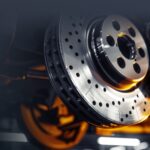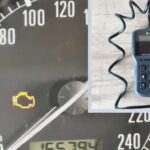Maintaining a modern vehicle can feel like navigating a complex maze of sensors, systems, and electronics. When that check engine light illuminates on your dashboard, it can be a moment of dread. However, understanding what’s happening under the hood has become significantly easier thanks to Obd2 Diagnostic Scanners. These tools are no longer exclusive to professional mechanics; they are increasingly accessible to car owners, empowering them to diagnose issues, save money, and ensure their vehicles are running smoothly.
But what exactly is an OBD2 scanner, and how can it help you? This guide will delve into the world of OBD2 diagnostic scanners, exploring their functionality, benefits, and how to choose the right one for your needs.
Decoding OBD2: Your Car’s Language
OBD2 stands for On-Board Diagnostics II. It’s a standardized system implemented in most cars and light trucks manufactured after 1996 in the United States (and similar timeframes globally). This system monitors various vehicle parameters, from engine performance to emissions, and reports any malfunctions through a standardized Diagnostic Trouble Code (DTC).
The OBD2 port, typically located under the dashboard on the driver’s side, acts as an interface to access this information. An obd2 diagnostic scanner plugs into this port, allowing you to communicate with your car’s computer.
Why Invest in an OBD2 Diagnostic Scanner?
Having an obd2 diagnostic scanner offers numerous advantages for car owners:
- Early Problem Detection: The most immediate benefit is understanding why your check engine light is on. The scanner reads the DTCs, providing clues about potential issues, from minor sensor malfunctions to more serious engine or transmission problems.
- Cost Savings: Instead of immediately rushing to a mechanic for a diagnostic check, which can cost money, you can use your own scanner to get an initial assessment. This allows you to be more informed when you do visit a repair shop, potentially preventing unnecessary repairs.
- DIY Car Maintenance: For those who enjoy hands-on car maintenance, an obd2 diagnostic scanner is an invaluable tool. It can help you pinpoint problems you can fix yourself, such as replacing a faulty sensor or tightening a loose gas cap.
- Preventative Maintenance: Regularly scanning your vehicle can help identify potential issues before they escalate into major breakdowns. This proactive approach can extend the life of your car and prevent costly repairs down the road.
- Verification of Repairs: After taking your car to a mechanic, you can use your scanner to verify that the reported problem has indeed been fixed and that the check engine light is truly off.
Types of OBD2 Diagnostic Scanners
The market offers a wide range of obd2 diagnostic scanners, from basic code readers to advanced professional-grade tools. Choosing the right one depends on your needs and budget:
- Basic Code Readers: These are the most affordable and user-friendly options. They typically read and clear DTCs, providing a basic understanding of the problem. They are suitable for simple diagnostics and clearing the check engine light.
- Enhanced OBD2 Scanners: These scanners offer more advanced features beyond basic code reading. They often include live data streaming, allowing you to monitor real-time engine parameters like temperature, RPM, and sensor readings. Some may also offer freeze frame data, which captures vehicle data at the moment a fault code was triggered.
- Professional Diagnostic Scanners: These are the most comprehensive and feature-rich scanners, often used by professional mechanics. They offer advanced functionalities like bidirectional control (allowing you to command vehicle systems), actuation tests, special functions (such as ABS bleeding, oil reset, and electronic parking brake release), and ECU programming capabilities. Brands like Autel are known for their professional-grade scanners, such as the MaxiSys Elite II Pro, which offers ECU programming for brands like Benz & BMW and comprehensive diagnostics.
Key Features to Consider in an OBD2 Scanner
When selecting an obd2 diagnostic scanner, consider these important features:
- Compatibility: Ensure the scanner is compatible with your vehicle’s make and model. Most scanners support OBD2 protocols, but some may have limited coverage for specific brands or older vehicles.
- Functionality: Determine the level of functionality you need. For basic check engine light issues, a basic code reader might suffice. For more in-depth diagnostics and maintenance, consider enhanced or professional scanners.
- Ease of Use: Look for a scanner with an intuitive interface and clear display. A user-friendly design will make the diagnostic process smoother, especially for beginners.
- Live Data: This feature is crucial for diagnosing intermittent issues and monitoring engine performance in real-time.
- Special Functions: If you perform your own car maintenance, consider scanners offering special functions like oil reset, EPB release, and ABS bleeding, which can save you trips to the mechanic.
- Update Capability: Vehicles and diagnostic protocols evolve. Choose a scanner that can be updated with the latest software to ensure compatibility with newer models and access to the latest features.
- Brand Reputation and Support: Opt for reputable brands known for quality and reliability. Good customer support and warranty are also important considerations. Autel, for example, is a well-regarded brand in the automotive diagnostic industry, offering lifetime customer support.
Maxisys Elite II Pro
ECU Programming Tool for Benz & BMW with comprehensive vehicle diagnostics & analysis
Shop Now
Using Your OBD2 Diagnostic Scanner: A Simple Overview
Using an obd2 diagnostic scanner is generally straightforward:
- Locate the OBD2 Port: Find the OBD2 port in your vehicle (usually under the dashboard on the driver’s side).
- Plug in the Scanner: Connect the scanner to the OBD2 port.
- Turn on Ignition: Turn your car’s ignition to the “on” position, but do not start the engine (unless instructed otherwise by your scanner).
- Follow Scanner Instructions: Power on the scanner and follow the on-screen prompts to initiate a scan.
- Read and Interpret Codes: The scanner will display any DTCs found. Consult your scanner’s manual or online resources to understand the meaning of these codes.
- Clear Codes (Optional): After addressing the issue, you can use the scanner to clear the DTCs and turn off the check engine light. However, it’s essential to properly diagnose and fix the underlying problem before clearing codes.
MaxiIM IM608S II Full Kit
All-in-one Top Key Programming Tool in Autel for professional locksmith
Shop Now
Choosing the Right Scanner for You
Selecting the best obd2 diagnostic scanner depends on your individual needs and technical expertise. For basic car owners who primarily want to understand check engine light issues, a basic code reader will suffice. Enthusiasts and DIY mechanics will benefit from enhanced scanners with live data and some special functions. Professional technicians require advanced scanners with comprehensive capabilities like bidirectional control and ECU programming.
Consider your budget, the types of vehicles you work on, and the level of diagnostics you need to perform. Investing in a quality obd2 diagnostic scanner can empower you to take control of your car’s health, save money on repairs, and enjoy greater peace of mind on the road. Explore reputable brands like Autel to find a scanner that meets your specific requirements and helps you unlock your car’s hidden secrets.
MaxiTPMS TS508WF
A new generation complete TPMS tool, provide faster and smarter TPMS repairs
Shop Now

